Formerly the Paradise Dancer, the beautiful 188-foot Dewi Nusantara was launched in 2008. Built to accommodate divers in comfort and style, the boat is exceptionally large with thoughtful details. There are eight deluxe staterooms that can be modified for couple or twin use. The very large (215 square feet) cabins have state-of-the-art bathrooms, desks and plenty of storage. The 495 square foot master cabin is a beautiful oasis on the ocean. The cabin's gorgeous furnishings, king-size bed, sitting area and a bathroom with a tub with ocean views are not standard on any liveaboard!
The boat is fully air-conditioned. The spacious common areas feature a dining room, a lounge and a huge deck area. All throughout the vessel you will find beautiful hardwood fitting for a three-masted motor schooner. Dewi Nusantara has two 28-foot fiberglass tenders and offers Nitrox. Diving itineraries include Raja Ampat, Triton Bay, the Banda Sea, the Forgotten Islands, Alor & Komodo. The boat can be chartered for private dive itineraries and adventure.
Master Suite
After a long day of diving amidst the beauty and marvels of Indonesian marine life, nothing feels better than unwinding in one of our opulent cabins. Our luxury boat cabins are the perfect place to rest, recoup, and prepare for the next day’s adventures.
The Master Suite, located in the aft quarters of the main deck, is the ship’s signature room and is a marvel of design and comfort. It occupies the vessel’s full width and has a 180-degree view of the ocean behind the ship from the stern. With its 46 square meters, it is the largest room onboard and indeed one of the largest suites available on any liveaboard in the world.
All furniture was specifically designed and manufactured by designer Bruno Helgen, adding to the luxuriousness and uniqueness of the cabin. The suite’s layout, bathed in abundant natural light, coupled with the awe-inspiring vista, will make saying farewell upon the voyage’s end an arduous task.
The Master Suite is one of the largest boat cabins aboard a dive boat in the world and offers lots of luxuries to pamper yourself. The Master Suite features a comfortable king-size bed and an en-suite bathroom, complete with a shower and a bath offering an ocean view. Guests also have their own air-conditioned sitting area, featuring a large corner sofa and a natural-shaped teak table.
Additional luxuries that come with our Master Suite boat cabin include extra storage in the wardrobe for all personal belongings and rear windows that can be opened for fresh air. On Dewi Nusantara, you can stay in luxury boat cabins that offer many enjoyable amenities and space that’ll make you forget you’re on a dive boat.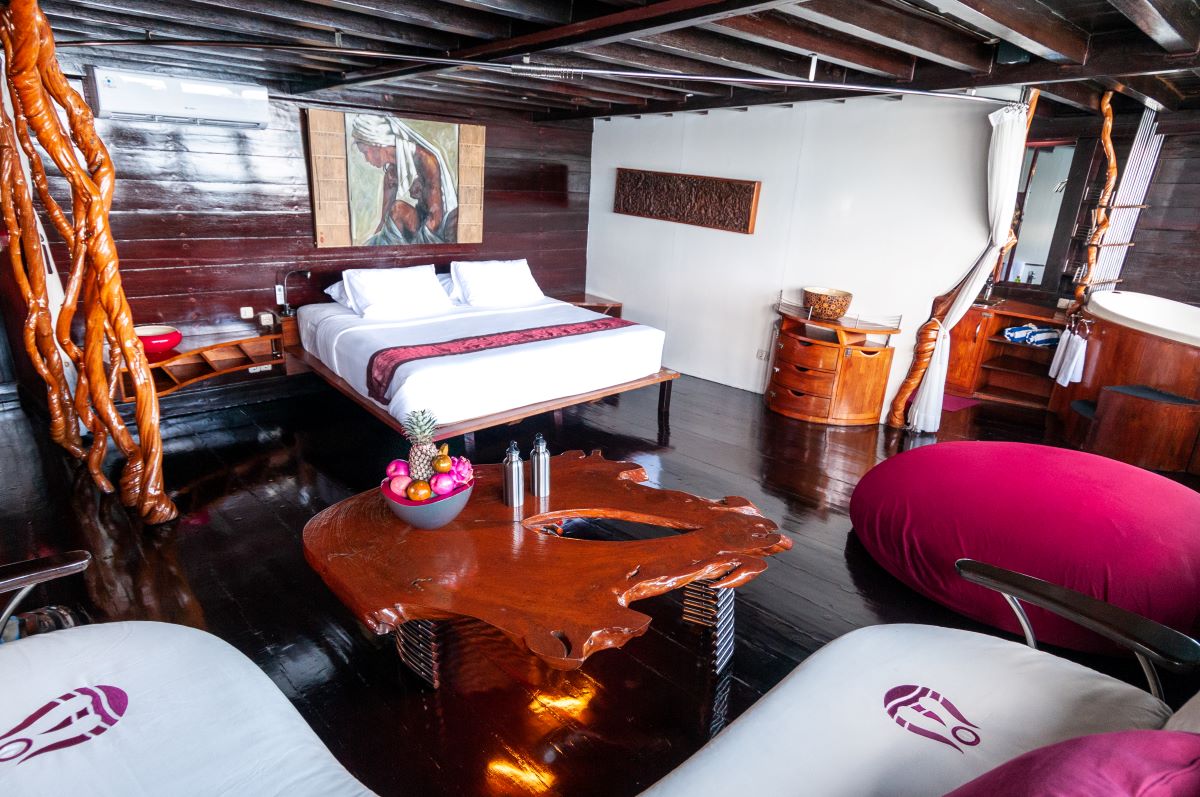
Deluxe Staterooms
The boat has eight Deluxe Staterooms on the lower deck. These air-conditioned staterooms are all individually designed. The rooms are spacious at 20 square metres and each have an individual color setting and unique carvings.
All Deluxe Staterooms are adaptable for either twin single or double-bed use.
Each has its own en-suite bathroom (4,5m by 1,3m), reading lights, 220V power points, a porthole and hanging / drawer storage for clothing. The room offers a comfortable desk if you like to work in privacy on your laptop. There is ample additional storage in the wardrobe for all personal belongings.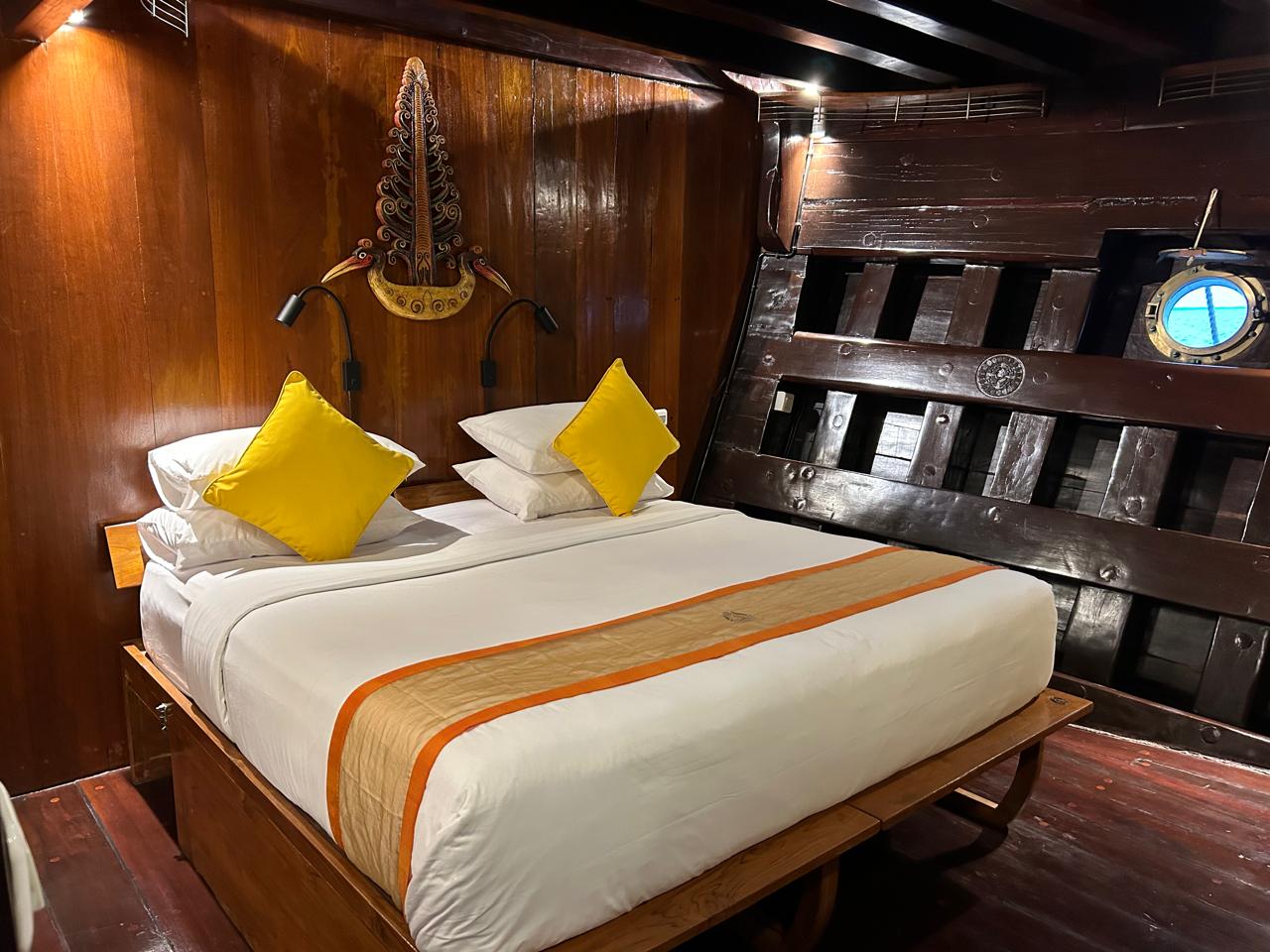
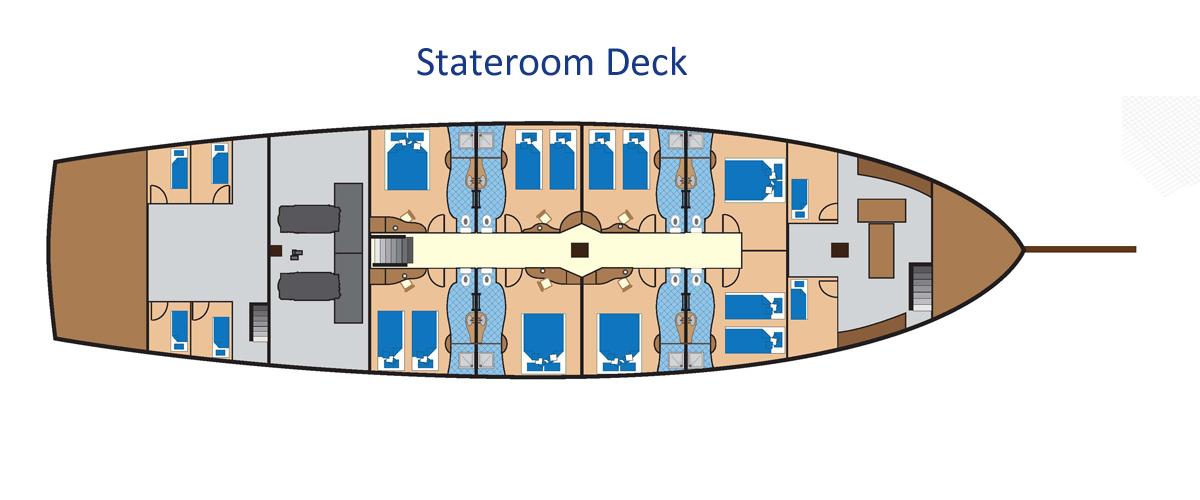
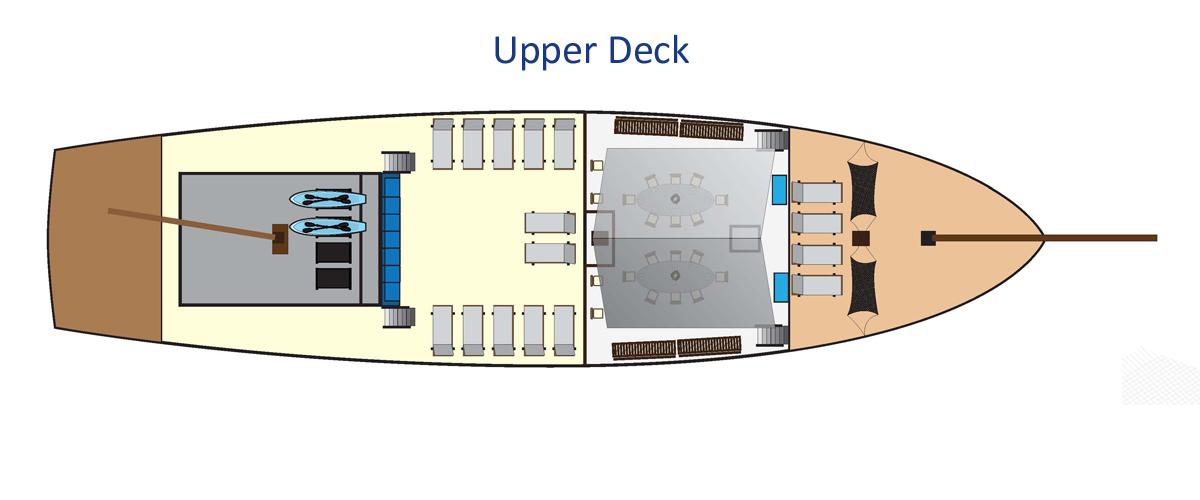
Built: Kalimantan (Borneo), Indonesia 2007-2008
Type: wooden 3 mast US top sail schooner
Length over deck: 158 feet (48 meters)
Length over all: 191 feet (58 meters)
Beam: 37 feet (12 meters)
Draft: 12 feet (3,6meters)
Total displacement: 800 tons
Propulsion: 2 x 500 hp Nissan twin turbo diesels
Fuel capacity: 29,000 liters
Desalinators production: 2 x 5,000 liters per day
Cruising speed: 8- 9 knots
Navigational aids: VHF, SSB, Furuno radar, twin GPS systems
Communication devices: VHF, USB Radio and satellite phone
Electricity: Two 100KvA and 50KvA generators – 220 volts
Number of passengers: 18
Accommodation: Eight double/twin “Deluxe Staterooms” 20 Square meter
Suites: One “Master Suite” 46 square meter
Lounge/Restaurant: 95 square meter
Dive/dining deck: 100 square meter
Sun deck: 80 square meters
Camera table: 10 meters with shelving
On the Dewi Nusantara's first trip of 2019 back to Cendrawasih Bay, guests enjoyed a respectful and organic interaction while marveling at the biggest extant fish species in the world, the whale shark. The worlds finest wilderness lies beneath the waves! Above the waves is equally wonderful wilderness in this remote area and the interaction with the local village indigenous tribe makes this trip even more special.
The Dewi has just 4 cruises to Cendrawasih scheduled for 2020 and 2021 with limited availability. If this is one of your bucket list ticks get booked on and come and join us to experience this epic adventure for yourself! See dates below.
Anybody who has ever encountered a whale shark during a dive knows what an awe-inspiring and humbling experience it can be. Like the graceful manta ray, whale sharks are great favorites with divers and just seem to glide though the water, without a care in the world, feeding on microscopic plankton and other small organisms while all you have to do is keep up with them for a photo or video scene. Now we present a whale shark encounter like no other, the Cendrawasih Bay Big Boys.
In Indonesia it is common, from Bali all the way to West Papua, for fishermen to utilise floating bamboo rafts, anchored to the seabed, to attract fish. Called FADs ( fish aggregation devices) or, more traditionally in Indonesia, rompongs, they are employed in open water ways from reefs to act like a floating weed bed habitat that will attract tiny fish and other marine life.
Once a community has been established under the device it is not long before more and progressively larger fish are attracted to it and fishing can commence.
Now, a variation of the rompong called a “bagan” is used in Cendrawasih Bay by the fishermen, almost all of whom are from Sulawesi incidentally. What these guys do is catch tiny bait fish in nets and hang them in the water as bait for the larger pelagic animals, to speed up the natural progression of life under the bagan. What happens here though is that they get a lot more than they bargain for. Whale sharks are not shy about adjusting their planktonic diet with something a little more substantial, bait fish for example, so these majestic creatures started to gather under the bagans and suck at the nets for a free meal. Fortunately for us and more so for the whale sharks, the local fishermen took their presence as a good luck omen!
As an extension of the fishermen’s interaction with these animals, dive liveaboards are now visiting the bagans and the fishermen allow divers to get in the water with them to film, photograph and observe these majestic beasts at their leisure. As their free feed is static, the whale sharks tend to stick around for quite a time and, as well as swimming around the platforms, have adopted a “vertical in the water” feeding position unique to the area. A bonus to this whale shark tea party is that it is also possible to catch a glimpse of some of the pelagics that the bagans are there to attract, with sightings of sail fish and marlin being recorded. * Jul-Aug.
Please contact us for availability, rates and travel arrangements.
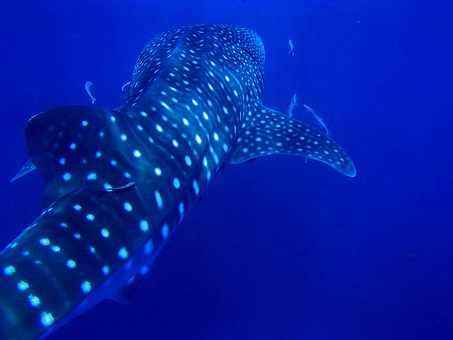
Welcome to Raja Ampat, the Realm of the Four Kings
Raja Ampat casts a spell on all who visit – scientists, photographers, novice divers, and crusty sea-salts alike. This group of majestic islands, located in the northwestern tip of Indonesia’s Papuan “Bird’s Head Seascape” lies in the heart of the Coral Triangle, the most bio-diverse marine region on earth.
Raja Ampat is all about diversity – not only diversity of species, but also of dive sites. There are some areas where soft corals and sea fans dominate, others with amazing diverse hard corals, seagrass beds, mangroves, shallow reefs, drop-offs, caves, black sand, white sand… Then there are the fish, lots of them, in more shapes and sizes than anywhere else in the world. Not only are there loads of fish, but all the levels of the food chain are well represented – from pygmy seahorses to top predators. In many places, brightly coloured soft corals can be found close to the surface, illuminated by natural sunlight, making these dive sites spectacularly colourful. The reefs in Raja Ampat just buzz with life.
Raja Ampat is huge, 50,000 sq km, with hundreds of islands and an astounding diversity of habitats, translating to wildly different diving experiences. They range from pelagic drift dives to magic muck dives and even some habitats that are special to Raja Ampat such as clear water mangroves with corals growing right next to them! There are thousands of potential dive sites. Exploration is still continuing, and on every trip there are chances for new and amazing discoveries. Even on a 12-day cruise, you will only have an opportunity to see some of what Raja Ampat has to offer.
Only a limited number of live-aboards obtained the license to dive the Raja Ampat Indonesia area, making this adventure even more unique and special.
Dewi Nusantara is the perfect platform that delivers modern comforts and outstanding service to adventurers exploring this remote outpost of civilization.
Raja Ampat: more than diving
Raja Ampat is also known for its spectacular above water scenery. Sparsely inhabited, most of Raja Ampat still has pristine rain forests atop dramatic limestone cliffs, uninhabited bays with white sand beaches and all sorts of hidden treasures to greet the intrepid explorer. It’s a kayakers dream, an intricate coastline with caves, bays, gorges, hidden rivers—all buzzing with exotic tropical wildlife.
A birdwatching hike on Gam Island might take you through scenic forests, past fragile orchids growing from cracks in the stone, and finally to the unforgettable experience of witnessing male birds-of-paradise doing their elaborate courtship dances to attract females.
Caving will bring you an exciting look into an amazing hidden world through a breath-taking underground experience. Also, look out for exotic historical artefacts and exciting remnants from World War II, such as crumbling forts and sunken bomber planes.
The friendly people of Raja Ampat have largely been able to maintain their traditional ways of life and traditional values, making it an interesting destination as well as an anthropological haven. There is a wide variety of community celebrations, including various types of music, dancing, singing performance and other fun!
Diving in Raja Ampat is true “Frontier Diving”.
See what the trip is like HERE
Dazzling Diving
All of Raja + More - 20% off
Dec 14-25, 2025
Dec 26, 2025-Jan 6, 2026
Jan 14-25, 2026
Jan 26-Feb 6, 2026
Feb 7-18, 2026
Mar 3-14, 2026
Apr 23-May 4, 2026
May 6-17, 2026
* Book by Dec 31, 2025
DEMA 2025 Group Deals
Full Charter - Take $5000 off + 2 FOC (2027 + 2028 trips)
Half Charter - Take $4000 off + 1 FOC (2026 trips)
* Book by Dec 31, 2025
Exclusive $1500 off per person
* Valid for 2025 season only. Limited availability. Contact us for AAT exclusive offer details.